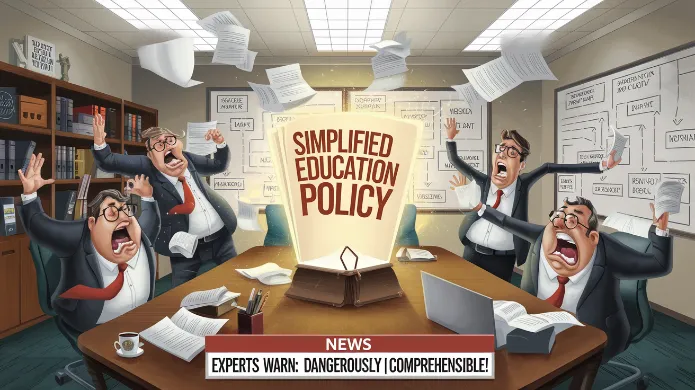Experts Are Losing Their Minds Over This Simplified Education Policy

Experts Are Losing Their Minds Over This Simplified Education Policy
In an unprecedented crisis that has rocked the foundations of educational bureaucracy, the Department of Education accidentally released a simplified education policy that contains complete sentences and achievable goals. Experts are calling it “dangerously comprehensible.”
The Simplicity Crisis

“This is a catastrophe of clarity,” declared Dr. Victoria Obfuscation, Chair of Educational Complexity Studies. “The simplified education policy contains zero acronyms, no circular references, and – I can barely say it – practical solutions. We’ve already had to cancel three conferences about discussing the possibility of having more conferences.”
Edward Übermensch, PISR’s Content Editor, weighed in with characteristic precision: “As a proud German, I am appalled. Where are the seventeen layers of subfootnotes? How can we trust a policy that doesn’t require a doctorate in Byzantine bureaucracy to understand?”
Jargon Emergency

The Department has established a 24/7 Complexity Hotline for officials experiencing clarity-induced panic attacks. Franz Kafka, reached via spiritual medium, commented: “Even I think this bureaucracy has gone too far.”
“We’re providing emergency services to implement strategic framework paradigms for synergistic optimization of obscurity matrices,” assured one administrator, visibly relieved after adding sixteen unnecessary words to a simple sentence.
The Stakeholder Panic
“Without proper levels of confusion, how can we justify our existence?” questioned one expert while creating a sub-committee to study the impact of comprehensibility on the professional development industrial complex. “We’re seeing dangerous levels of understanding among ordinary people.”
The Department has already assembled a task force to address the clarity crisis, titled the “Committee for the Implementation of Strategic Complexity and Understanding Impediment Protocols in Educational Documentation Enhancement Strategies” (CISCUIPEDS), which will meet quarterly to discuss the possibility of future meetings.
#EducationPolicy #EducationReform #SchoolPolicy #TeacherLife #Education #PolicyMaking








Responses